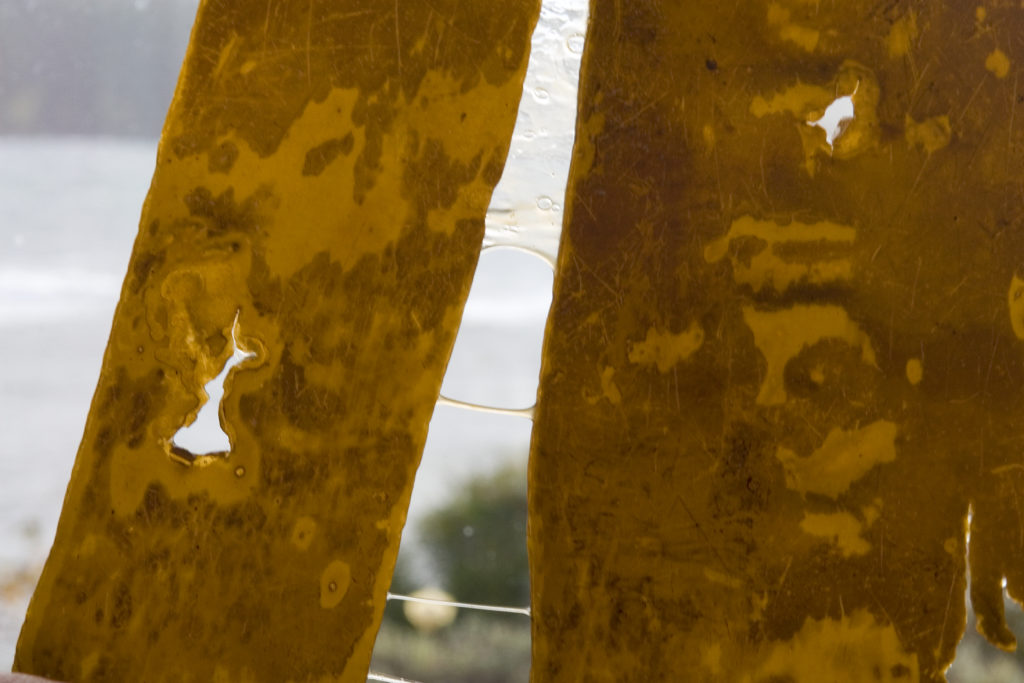The Future is Seaweed!
While seaweed is already a completely sustainable future food source, as it doesn’t need fertilizer, farming or deplete any soil of its nutrients, seaweed also absorbs carbon dioxide and releases oxygen as it grows. It is extremely fast growing and a nutrient-rich, bioavailable ingredient that contains many beneficial compounds all in one! Bull Kelp grows up to 2 feet (60cm) per day in perfect conditions. Seaweed is one of the best dietary forms of iodine, while its many vitamins, minerals and essential nutrients, applied topically, do nothing but benefit, moisturize and help heal the skin. The future is seaweed! While more and more skincare companies and health markets are catching on to the amazing nutrient-rich source, Seaflora remains one of the few skincare companies to use 50% or more seaweed base in all of their skincare.
Bioavailability
Bioavailability is measured by the fraction (%) of absorption measured by how much of an administered product is absorbed into the blood stream. Did you know that most transdermal patches contain a thin layer of alginate that builds the delivery system through the dermal layers, delivering whatever drugs or hormones are on the transdermal patch? For example, a nicotine patch, would have a thin layer of alginate on it to build the delivery system for the nicotine to the blood stream. So when you use raw, wild, organic susperfood as the main ingredient in your product, it is best to only incorporate the purest ingredients to compliment such a powerful main ingredient.
Seaweed gives your body all of the vitamins, minerals, fatty acids and other nutrition it needs to slow down the aging process and give you the healthy glow you want! Too often in the skincare industry we are sold on ideas that make sense but simply don’t work. For example, applying topical Retinol A creams to your skin can cause redness, swelling, peeling and blistering in treated areas, especially for people with sensitive skin. It may also cause or aggravate eczema, particularly atopic dermatitis. In order to allow your body to produce the Retinol A you want, you need to supply it with the tools, which of course are all found in that amazing superfood, seaweed.
Vitamin A is an essential nutrient that supports skin, eye, and reproductive health, and immune function. There are two types of vitamin A: retinoids (preformed vitamin A) and carotenoids (proformed vitamin A). Both types are converted to retinol by the liver, and boost the production of elastin and collagen. A lot of what is applied topically to the skin doesn’t have the desired effects you’re looking for, and it took a lot of cleaver marketing campaigns to convince you they would! Another example of this would be Soluble Collagen. Even the name would suggest it would deliver the collagen we so desperately seek, and yet soluble collagen will only make your skin softer when applied through a skin care cream. Forget peptides, poly-peptides or olgy-peptides, your body needs full chain amino acids and copious amounts of Vitamin A1, so it can produce the collagen it needs to produce collagen and restore the skins’ elasticity.
Is Seaweed a Potential Solution?
Thankfully, according to Science Direct, seaweed proteins contain all amino acids, particularly glycine, arginine, alanine, and glutamic acid. Lots of species of red seaweeds were also recently found to have 5.4 mg of beta-carotene per 100g of seaweed, which is a high level compared to land vegetables. Out of the 90+ minerals and 60+ trace elements, Kelp has also been found to contain the following essential vitamins and minerals;
- Vitamin K1: 55 percent of the Daily Value (DV)
- Folate: 45 percent of the DV
- Magnesium: 29 percent of the DV
- Iron: 16 percent of the DV
- Vitamin A: 13 percent of the DV
- Pantothenic acid: 13 percent of the DV
- Calcium: 13 percent of the DV
All of these vitamins and essential nutrients have specific health benefits! For example, vitamin K and calcium play a key role in bone health, while folate is essential for cell division. Seaweed’s future in the skincare industry is sure to be a growing trend, but did you know seaweed is also used as a thickening agent in paint, toothpaste and other everyday items? According to Mintel’s Global New Product Database (GNPD), from January 2011 to October 2015 roughly 2% of body care products launched contained a seaweed ingredient(s). Of these, brown seaweed and red seaweed are the most common types of seaweed species used, and being the fastest growing plants on Earth they offer true sustainability like no other weed or plant. Today, algotherapy is becoming more and more popular around the world as more people are realizing the amazing benefits of seaweed as an active component of skincare for it’s MAAs, Fucoidan, Mannitol, and other unique compounds.

The Future of Skincare is Seaweed!
Did you know seaweed could be the miracle cure for cellulite? That’s right! According to Mintel GNPD, global body care products with brown seaweeds (Laminaria and Rockweed) claimed a larger percentage of all three body contour claims – firming, slimming and anti-cellulite. When compared to the global body care category (without seaweed ingredients) from January to October 2015, seaweed was a winner! We continue to see seaweed popularizing trend among holistic skincare enthusiasts and people looking for natural alternatives for health and wellness. Seaflora’s Seaweed Body Wrap won them Top Spa Partner of Canada in 2018, and seaweed body wraps are traditionally one of the most popular spa body treatments in North America and Europe.
Protein modulation, enzyme suppression, DNA repair, anti-viral properties, anti-fungal properties, the list goes on and on! Is there anything seaweed can’t do? Dr. Sebi has recommended Sea Moss for decades as perfect cell food, that heals the body back to health from even some life threatening illnesses. Vegans who are having a hard time sourcing enough protein should be looking to seaweed as the answer, as red seaweeds provide up to 50% their dried weight in complete proteins.
Why Seaweed is the Future
Seaweed around the world is being researched for developing a more sustainable, earth friendly and pro health future. Not only do kelps provide superfood nutrition, did you know that seaweed is a sustainable food source? Did you know that kelp forests already provide us more oxygen than all the land forests combined? What’s more, is seaweeds are showing promising results as a replacement for plastic cups, straws, and packaging! Biodegradable materials are already being made from brown seaweeds that can be turned into a variety of products that would typically be made from plastic such as sauce packets and disposable containers.



